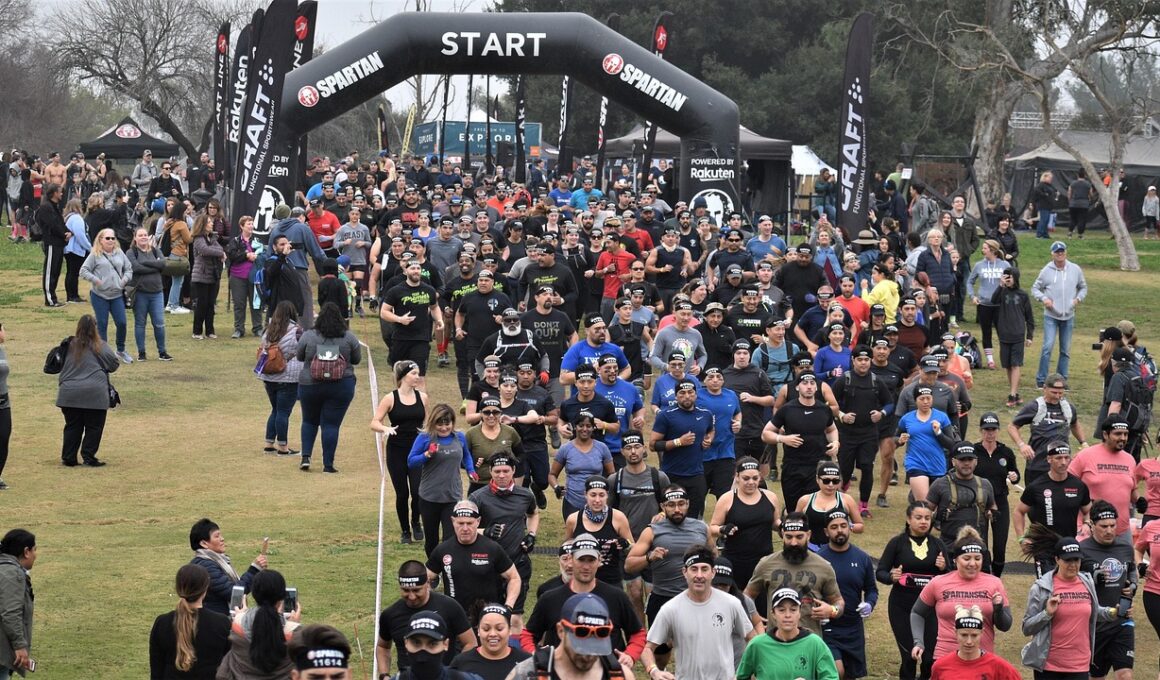From Steps to Scores: Measuring Success in Gamified Fitness Programs
In recent years, gamified fitness challenges have rapidly gained popularity as a method for enhancing physical activity and engagement. These programs incorporate elements of gaming into workouts, making fitness more enjoyable while encouraging users to reach their health goals. Participants often find increased motivation as they accumulate points, compete for rewards, and share progress with friends. The competitive aspect can foster a sense of community as individuals push each other to achieve milestones. As the fitness industry continues to innovate, the integration of technology plays a critical role in shaping these challenges. Mobile applications and wearable devices track performance metrics, allowing users to see improvement over time. Programs can be tailored to fit different fitness levels, ensuring inclusivity for all participants. With the potential to transform sedentary lifestyles, gamified fitness has opened up new avenues for healthy living. Health and wellness organizations are now prioritizing the development of engaging experiences that help users stay interested and accountable in their wellness journeys. Embracing this trend allows fitness providers to capitalize on the benefits of gamification, fostering sustainable habits among participants.
Gamification not only enhances user motivation but can also lead to significant improvements in fitness outcomes. Users who engage in gamified programs often report increased adherence to their exercise regimes due to the enjoyable format and achievement recognition. Innovative challenges, such as step competitions or virtual races, create excitement around achieving specific targets. Participants can often share their achievements on social media or earn badges that can further incentivize their commitment. Moreover, engaging with an online community of like-minded individuals fosters camaraderie and friendly competition, which are vital for maintaining long-term motivation. As fitness professionals seek to optimize these experiences, they rely on data-driven insights to understand participant behavior. Analytics derived from user activity can inform future challenges, allowing for personalization and adaptation according to the needs and preferences of the target demographic. As the data reveals success trends, fitness providers can adjust their offerings to ensure continual user engagement. Implementing effective strategies grounded in user analytics can enhance the overall experience, ensuring individuals find meaning in their fitness journeys. The future of gamified fitness thus continues to evolve, combining enjoyment and results in groundbreaking ways.
Building a Successful Gamified Fitness Program
Designing an effective gamified fitness program hinges on several critical components. First, it is essential to establish clear objectives that participants can realistically achieve within stipulated timelines. These goals should be adaptable, allowing users to progress at their own pace while preventing frustration from unattainable expectations. Second, incorporating varied challenges to cater to different abilities is vital. Activities could range from daily step counts to month-long workout streaks, encouraging broader participation. Third, ensuring the rewards system is enticing plays a significant role in retention; appealing rewards will motivate individuals to keep participating. Possible rewards might include virtual trophies, gift cards, or discounts on fitness gear. The implementation of social features can enhance accountability by enabling score sharing among users, thus promoting friendly competition. Additionally, regular feedback and progress tracking are necessary to guide participants toward success and highlight improvements over time. Mobile applications playing a crucial role in this ecosystem can digitally facilitate engagement and convenience. Attractive features like leaderboards can further accentuate the competitive aspect, driving users to strive for improvement and subsequently leading to better health outcomes.
To assess the success of gamified fitness challenges effectively, it is important to monitor and analyze specific performance metrics. One commonly used metric is the engagement rate, which can indicate how actively participants are involved in the program. Tracking user retention rates reveals how many participants continue to engage over time. A high retention rate generally suggests that the program is maintaining its appeal and effectiveness. Additionally, measuring user progress and performance improvements provides insights into the program’s overall impact on physical fitness. These evaluations can be complemented by collecting qualitative feedback from participants through surveys and interviews. Participants’ testimonies can highlight successes or areas needing improvement, offering invaluable insights into the effectiveness of challenge design. Furthermore, comparing user results against industry benchmarks creates a broader context for assessing success. All this data helps refine program offerings, ensuring that gamified fitness remains relevant and effective in fostering healthier lifestyles. By continuously optimizing based on participant feedback, fitness organizations can surge ahead in building valuable communities that prioritizes health and wellness.
The Role of Technology in Gamified Fitness
Technology is a fundamental ingredient in the success of gamified fitness challenges. The use of mobile applications, wearables, and artificial intelligence can enhance user experiences significantly. These tools allow users to monitor their performance with unprecedented accuracy and provide personalized feedback tailored to their fitness levels. Mobile applications often feature interactive interfaces enabling users to track daily activities, compete with friends, or visualize their progress via charts and graphs. With wearables, data such as heart rate, calories burned, or distance traveled can be analyzed in real time, keeping users informed and engaged. Furthermore, the integration of augmented reality (AR) and virtual reality (VR) is slowly emerging in fitness programs. These technologies can create immersive experiences that motivate individuals to participate actively. Social media integration is also vital, as connecting participants allows for sharing achievements, further promoting community engagement. Such technological developments continually reshape the fitness landscape, blurring lines between gaming and working out. As organizations invest in innovative tech solutions, they can capture the imaginations of users and create truly engaging experiences within the fitness industry.
As the gamified fitness trend continues to grow, fitness professionals must prioritize inclusivity and accessibility within their offerings. Recognizing that not all individuals are progress-driven athletes is crucial. Creating challenges that cater to various fitness levels and demographics ensures that everyone can participate and benefit. Flexible challenges can accommodate different abilities and preferences, from walking steps to strength training or yoga. Companies can also consider providing entry-level alternatives, such as non-competitive challenges, for newcomers. Accessibility means also considering digital inclusion; ensuring that programs are compatible with different devices like smartphones and tablets promotes participation among diverse populations. Workshops and community events can further bridge the gap, introducing gamified fitness concepts to broader audiences. Education on how to use these tools effectively is essential, as many potential participants may feel hesitant about technology use. Promoting an inclusive environment encourages camaraderie, fostering personal connections between participants. A well-rounded approach to inclusivity can empower individuals to engage in fitness positively. By embracing diverse fitness approaches and welcoming everyone, the fitness industry can maximize the benefits of gamified fitness challenges for all participants.
Future Trends in Gamified Fitness
Looking ahead, the future of gamified fitness presents exciting possibilities that could redefine engagement strategies. One notable trend is the integration of artificial intelligence to personalize experiences for users comprehensively. By analyzing data on individual preferences and performance, AI can create highly tailored challenges suited to specific needs. This level of personalization can enhance motivation and optimization of fitness routines, ultimately driving better results. Additionally, an emphasis on wellness beyond physical fitness, such as mental health and mindfulness, is increasingly evident in gamified programs. Virtual challenges may include stress-relief activities or meditation, promoting holistic well-being. Wearable technology advancements could introduce real-time health metrics, like stress levels or sleep quality, allowing users to monitor multiple facets of wellness and fitness. Collaborations between fitness apps and wellness brands may also become popular, presenting users with unique package offerings combining fitness with holistic approaches. As the fitness industry continues to evolve, integrating virtual reality experiences into gamified fitness programs can further enhance user modernization. Such advancements promise to elevate user engagement, encouraging comprehensive lifestyle changes and fostering long-term health benefits in gamified fitness programs.
Ultimately, the engagement and success of gamified fitness initiatives rely heavily on continuous innovation and adaptation. As user expectations evolve, fitness brands must remain nimble and responsive to feedback and emerging trends. Implementing new features driven by participant preferences can position organizations as leaders in the industry, fostering broader loyalty among users. The commitment to maintaining an engaging environment through regular updates and features will ensure participation remains lively. Additionally, these initiatives encourage users to take ownership of their fitness journeys, creating a sense of accountability. Moreover, as new technologies emerge, fitness providers can leverage them to create even more interactive and engaging programs. A balanced blend of competition and collaboration can cultivate positive relationships among participants, enriching the overall experience. Building long-term communities focused on health and wellness ensures participants never lose sight of their goals. A robust gamified fitness program can empower users to discover their potential while rewarding their efforts. By adapting to trends and innovation within the fitness industry, organizations can enhance their offerings while encouraging individuals to achieve their health aspirations. The future of fitness ultimately looks promising, reflecting a commitment to sustainable lifestyles through engaging experiences.


